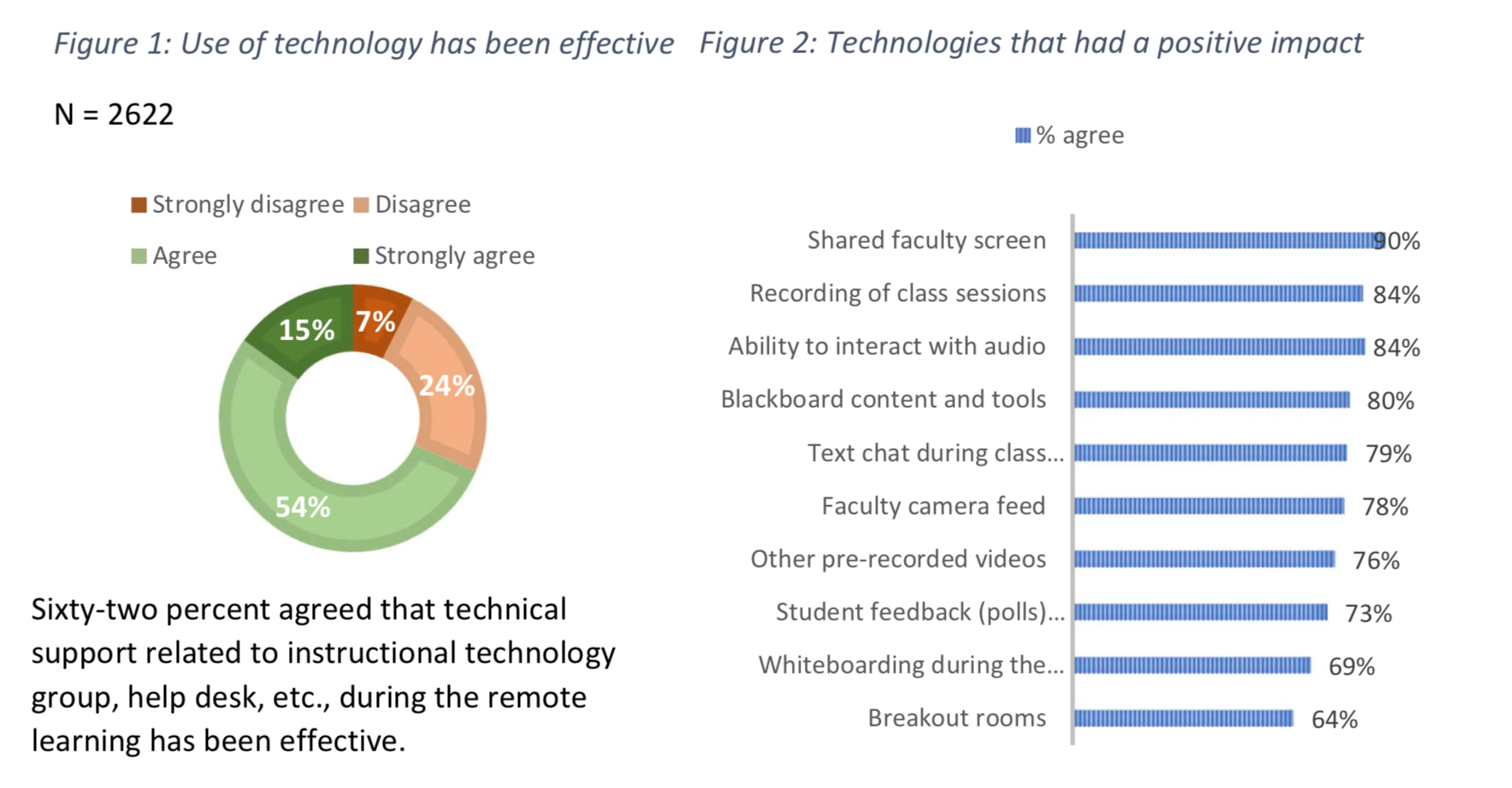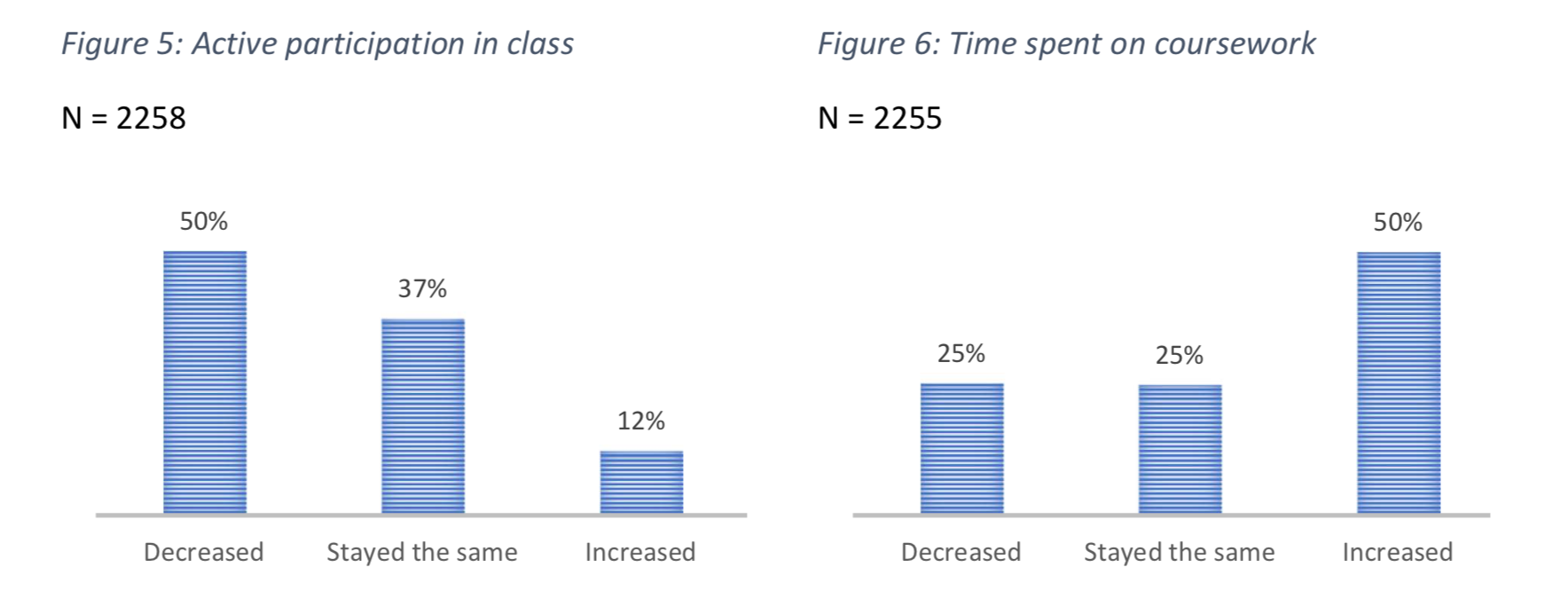Spring 2020 Remote Learning Survey Results
Administered by the Office of the Provost and the Remote Teaching Task Force
As Drexel adjusted to fully remote instruction for spring term, and looks ahead to the summer term, the Office of Provost and the Remote Teaching Taskforce developed a survey to learn which aspects of the remote learning experience are working well and which warrant additional study and improvement. The survey was administered to 18,081 enrolled students in the spring term either in face-to-face or hybrid classes. The survey was launched on May 13th and responses were collected till May 27th. The response rate was approximately 16% with 2818 students responding to the survey.
Key recommendations for remote courses:
- Recorded Lectures: Faculty should, whenever possible, record lectures and presentations. Students find these recordings especially helpful. They can revisit the lectures to review material, make up missed classes, and study for exams.
- Online Materials: Students find Blackboard Learn, online exams, and course materials, including slides, very helpful. Faculty should use these tools in a robust way, ensuring that materials are easy to access and review.
- Web Conferencing: While students did experience “Zoom fatigue,” Collaborate or Zoom for meetings, office hours, screen-sharing and whiteboard conveyed clear benefits for students in the remote context. In particular, students expressed the desire for office hours to be held at different times (including at night), and many expressed the wish to have online office hours as a continued practice even when we transition back to hybrid and in-person classes.
- Increased Engagement: While it’s inherently difficult to provide interpersonal engagement in remote classes, student responses make it clear that students crave more engagement, both with their instructors and with their fellow students. Faculty should explore ways to facilitate this, using tools available, and flexibility. Many students felt they were less likely to “raise their hand,” for instance, as Zoom sessions can be a bit chaotic and busy and the discussions disjointed.
- Exams: Students reported finding timed exams particularly stressful in the remote context, particularly as their test-taking conditions can vary so much, with household and family distractions, etc. While this feedback may suggest that faculty need to assess whether they are giving enough time for taking a particular exam – and to increase it if necessary – it should not result in the removal of testing time limits in general. Time limits reflect the natural testing environment that would occur in an in-person class period and also help assess student proficiency with the material.
To provide additional detail, we offer the following snapshots of students’ responses. We intend to follow this brief survey with focus groups to obtain greater understanding of the student experience in remote courses and will pass on to faculty what we learn.
Positive impact of technology
Sixty-eight percent of respondents agree with the statement that the use of technology in the remote learning environment has been effective. When asked to rate their level of agreement on the technologies that had a positive impact on remote learning, 90% agreed that shared faculty screen played a crucial role in students’ learning experience while 84% found the recording of class sessions to be a positive factor (see Figure 2).

Student engagement needs to improve
Engagement in the virtual environment was a challenge that needs to be addressed as reflected in the responses to statements such as opportunities for online tutoring, engaging with fellow students, or with instructors (see Figure 4). Some of the concerns highlighted in the open-ended feedbacks relate to:
- Communication: student to student, student to instructor, running into people between classes
- Connectivity (Interpersonal): getting to know students and instructors, feeling isolated or disconnected, missing people’s faces, physical interaction
- Engagement: fellow students not engaged with discussion, work not as engaging, instructor use of technology not engaging, not necessarily more synchronous time, not more work
- Collaboration: issues with group work, lack of studio experience

Students did however appreciate the online availability of instructors, including office hours, chats, etc. in the remote setting and expect to see more of it even when classes resume in a face-to-face environment. Also, in the remote setting students feel that their participation in class such as asking and answering questions, joining the discussion, commenting, etc. has decreased (see Figure 5) and at the same time, the amount of time spent on coursework has increased (see Figure 6). One potential reason could be more work being assigned to students in place of class time or even the lack of participation during class time and spending more time understanding the subject matter.

External factors hampering student learning experience
A majority of the students agreed to the statements related to having the appropriate technology (90%) and sufficient internet access and bandwidth (82%) to participate in remote learning, but 27% disagreed with the statement that they had necessary physical space to effectively participate in remote courses (see Figure 7). Respondents highlighted concerns related to:
- Distractions: issues with space at home, interruptions from family or others in the home, outside noise, no classroom space for lectures, lack of study space
- Time Zone: issues with being temporally displaced from Philadelphia (EST/EDT)
